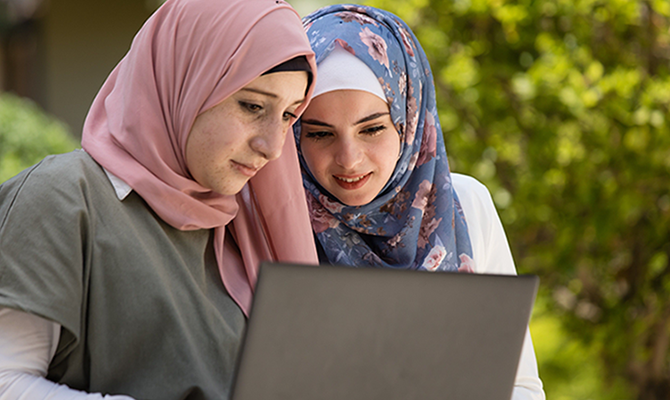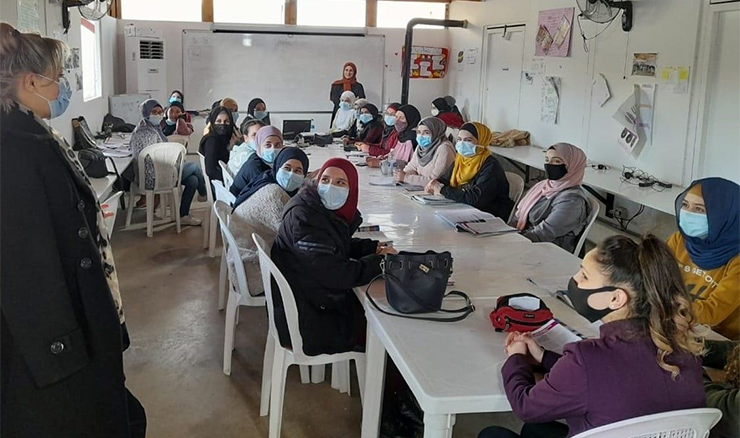 [1]
[1]In many ways, education, and higher education in particular, is more out of reach today than ever before for young Syrian refugees, who UNICEF once worried would become a “lost generation.” Above two HOPES Syrian students in Egypt. ⓒHOPES2019
Refugees already make up one percent of the global population, and their numbers are on the rise. Conflicts in Afghanistan, Burkina Faso, the Democratic Republic of the Congo, Ethiopia, Iraq, Syria, Sudan, and, most recently, Ukraine have forced more than 100 million to flee from their homes, according to recent statistics from the United Nations High Commissioner for Refugees (UNHCR) [2].
Often unable to bring much in the way of money and possessions with them, refugees are frequently forced to rely on humanitarian assistance to meet their basic needs.
But while international agencies and governments often focus on providing basic humanitarian assistance to displaced people, providing education, and higher education in particular, can seem like less of a priority. But given the impact of lost years of education on the future of younger generations, and the unfortunate reality that many conflicts last years, every avenue to educating refugees must be explored.
Recent tragedies have much to teach us. Since it began over a decade ago, the war in Syria has disrupted the lives of millions, forcing 6.6 million [3] Syrians to seek shelter in other countries. Many of them are school- or college-age: Today, around a quarter [4] of Syrian refugees are under the age of 17.
In many ways, education, and higher education in particular, is more out of reach today than ever before for young Syrian refugees, who UNICEF once worried would become a lost generation [5]. As the war in their home country has dragged on, the interest of the international community in their plight has gradually diminished, while few sustainable initiatives have been adopted that would provide education to Syrians, or to any other refugees in the world, on an ongoing basis.
Understanding what policies have and haven’t helped not only reveals a way forward to educating more Syrians, but sheds light on what should be done to respond to other refugee crises around the world.
Resettlement Options: A Gloomy Reality
Developing countries, mainly in sub-Saharan Africa and the Arab region, host 85 percent of refugees [6]. For example, around 85 percent [4] of Syrian refugees have been resettled in neighboring countries in recent years, all of which the International Monetary Fund considers developing economies [7].
In developing countries, many factors limit refugees’ access to education, and higher education, in particular. These include limited resources of the host country to fund educational services and a shortage of information on the opportunities available to refugees. Moreover, the unstable political situation of many of developing host countries and their often shaky economies can make living conditions very harsh for both refugees and residents.
These refugees also face the same difficulties that those resettling in more developed countries face, such as an inability to access academic documents from their home countries, the challenges of adapting to different educational systems and languages of study, as well as other social and cultural barriers.
Despite the important role higher education plays in enhancing refugees’ life chances, these factors make enrolling in a college or university a luxury for many refugees.
“It is estimated that only three percent of refugees were enrolled in higher education in 2021. This figure stands in contrast to a global gross enrolment ratio in higher education of 38 percent worldwide in 2018,” according to a new policy paper [8] publish last month by the UNESCO International Institute for Educational Planning (IIEP-UNESCO) and UNHCR.
Those figures are far from the ambitions outlined by UNHCR in 2019, when it announced [9] a goal of having 15 percent of refugees enrolled in higher education by 2030. In the years since, the outbreak of new conflicts, deteriorating political and public health conditions in many host countries, and a continued absence of policies supportive of refugee education have likely made the situation even worse.
Scholarships: A Temporary Lifejacket
For many refugees, scholarships are the only available pathway to higher education, especially in developed host countries, where higher education can be prohibitively expensive. During the last decade, many programs have been created or developed for this purpose. Still, the available scholarships are less than the real, and growing, demand.
For example, UNHCR’s Albert Einstein German Academic Refugee Initiative (DAFI), offered only 402 new scholarships in 53 countries around the world to refugee students out of 3,026 applications received, according to their 2020 annual report [10].
Moreover, global economic tremors and the pandemic have already forced cuts to some current programs and even halted others. “The overall situation is definitely dramatic and, to be realistic, there is so little we can offer as an alternative pathway to education,” said Carsten Walbiner, director of the HOPES-LEB program [11], which is funded by the European Union through the ‘EU Madad Fund’ and implemented by a European consortium led by the German Academic Exchange Service (DAAD).
 [12]
[12]Meeting with student beneficiaries of the STEP program in Bekaa, Lebanon as part of the HOPES-LEB scholarship program for short-term courses in collaboration with the Center for Civic Engagement and Community Service (CCECS), American University of Beirut. ⓒHOPES-LEB2022
The HOPES-LEB program grew out an earlier, more expansive initiative: the HOPES project. Begun in 2016, the HOPES program provided access to quality higher education for Syrian refugees and other vulnerable youth in the host communities of Egypt, Jordan, the Kurdistan Region of Iraq, Lebanon, and Turkey. Although the HOPES program ended in 2020, its successor, HOPES-LEB, will continue in Lebanon until 2023.
But even the few programs that have been introduced to help refugees enroll in higher education face the very real threat that their funding will dry up as the attention and interest of the international community shifts.
Walbiner acknowledges that political interest in the Syrian crisis has declined, despite the still precarious circumstances of many Syrian refugees and the deteriorating economic conditions in many host countries.
“Soon the MADAD fund will no longer exist. They are just finalizing their activities and it won’t be renewed, there is no way to raise larger amounts of money for Syria right now. International organizations are busy now with the new crisis in Ukraine and local governments are extremely exhausted.”
Lessons Learned
Avoiding the mistakes that helped create this bleak outlook for Syrian refugees’ access to education is imperative.
“Long term thinking should be a serious consideration,” Yannick du Pont, founder and chief executive of Spark [13], a Dutch nonprofit organization that promotes higher education and entrepreneurship in conflict-affected countries, said in an interview with WENR. Spark has already awarded around 12,000 scholarships for Syrians to pursue a bachelor’s degree or vocational training in Syria, Jordan, Lebanon, Turkey, Iraq, and the Palestinian Territories.
“Everyone, including myself, was programming for short periods believing that Syrian war would end soon. But it has been more than 10 years now and the situation is still shaky.”
To address this challenge, Du Pont suggests investing more in the current educational systems and working more with locals “as they will really need to carry the burden for a longer time. And I think it’s only fair to invest more locally.”
Walbiner agrees with Du Pont on the importance of working with and supporting local communities and admits “that long-lasting political crises have become a reality we have to reckon with. They are different from natural disasters which ‘only’ require the reconstruction of infrastructure. Political crises have a protracted and complex character and make a profound impact on educational systems.”
Other steps should also be taken. The IIEP-UNESCO/UNHCR policy paper mentioned above identified 15 measures that communities can adopt to help remove barriers to higher education for the refugees that they host. These measures include recommendations that the educational rights and needs of refugees be incorporated into all educational policymaking and planning activities and documents. They also include calls for data and other information on refugee education, both in their host and home countries, to be collected and publicly disseminated, and for flexible credential evaluation policies and procedures to be adopted. Another measure recommends that pathways that prepare refugees to enroll in the host community’s academic institutions be developed.
But perhaps most importantly, the policy paper recommends that funding be made available to colleges and universities to support refugees.
Experts believe that ensuring that refugees can access high-quality education is more important now than ever. “Investing in refugees’ education is not cheap; it really costs a lot of money. But I would say it’s more useful to invest in it than not,” Walbiner said, stressing that “knowledge is a value in itself, definitely, and it also creates hope.”
He added, “I’m not a specialist on Ukraine, but I think that many of the lessons we learned when working with refugees from Syria are valid all over the world. Still, little has been done to learn from these experiences to make future interventions more effective and more sustainable.”
